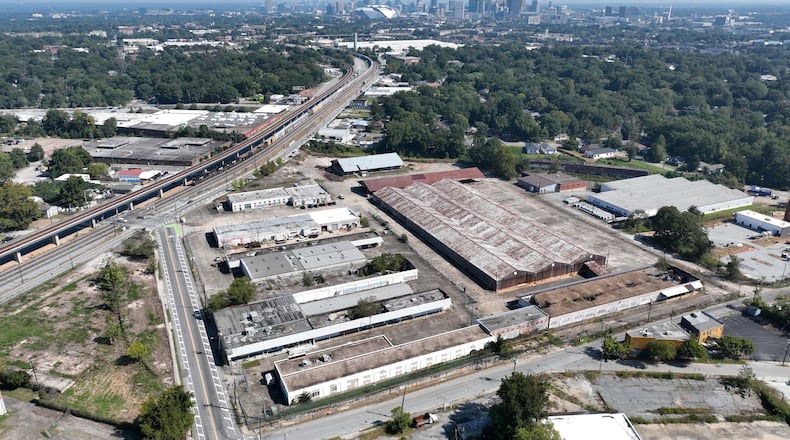One of the largest projects along the Atlanta Beltline is moving forward, aiming to provide affordable homes and workspaces to hundreds of people in an underinvested part of the city.
Beltline officials and Invest Atlanta, the city’s economic development arm, announced Thursday they’ve finalized the selection of Culdesac Inc. and Urban Oasis Development to handle redevelopment of the 20-acre Murphy Crossing site. The project is expected to include approximately 1,100 housing units and up to 180,000 square feet of commercial space, both with significant affordability components.
The mixed-use project on the former State Farmers Market property at 1050 Murphy Ave. SW ranks among the most consequential developments on land owned by the Beltline. Its scale and requirement that 30% of residences be reserved for low income families also positions it to influence how the Beltline incorporates affordable housing and retail space on other developable land the agency owns on the 22-mile trail loop that has triggered a surge in land and home values.
“Once you own and control the dirt, you can do deep and long-term affordability, perhaps even permanent affordability,” Beltline CEO Clyde Higgs said in a recent editorial meeting with The Atlanta Journal-Constitution.
Murphy Crossing, located near two MARTA stations, has long been targeted for redevelopment, but those plans have struggled to gain momentum.
The Beltline spent several years acquiring all the parcels that comprise the site, and it took two rounds of public calls seeking development partners before a team formed.
Arizona-based Culdesac and Atlanta-based Urban Oasis were selected as finalists in September 2022, and it took the following 17 months to negotiate project specifics and incorporate community stakeholder feedback, said Dennis Richards, the Beltline’s vice president of housing policy and development.
Credit: Atlanta BeltLine, Inc.
Credit: Atlanta BeltLine, Inc.
The project will apply with low-income housing tax credits, but information on other potential incentives were not immediately provided.
Atlanta Mayor Andre Dickens championed the development team’s selection as a milestone to delivering a long-sought project in a historic — albeit often ignored — corner of the city.
“The Murphy Crossing development will bring new mixed-income housing options to the heart of our city, create a walkable district with access to transit and the Beltline, and provide affordable commercial space to support entrepreneurship and businesses in Southwest Atlanta,” Dickens said in a statement.
From robust to rust
The Murphy Avenue industrial site used to act as the beating heart of Oakland City, an area three miles southwest of Mercedes-Benz Stadium with a peculiar history among Atlanta neighborhoods.
Oakland City was briefly its own city in the late 1800s before it was annexed into Atlanta in 1910. Known as the home of some of Atlanta’s oldest still-standing bungalows, the neighborhood saw its demographics shift from majority white to predominately Black by the middle of the last century.
The neighborhood was among the hardest hit after the Great Recession’s foreclosure crisis, but Oakland City and its adjacent neighborhoods have recently seen an increase in real estate speculation and activity, spurred in part by the Beltline. Developments like Lee + White and Pittsburgh Yards have drawn even more attention to that stretch of the Beltline’s Westside Trail.
The Murphy Crossing site used to be home to the State Farmers Market, but the bustling area has deteriorated into a series of rusted and mostly vacant warehouses and buildings. Recently, the property served as the post-apocalyptic backdrop in the “Hunger Games” series.
Credit: Miguel Martinez
Credit: Miguel Martinez
A stakeholders advisory committee consisting of Atlanta councilmembers, neighborhood planning unit leaders and other community members helped refine Murphy Crossing’s development plan. Richards said the revised vision focuses on dense housing and commercial shop spaces, especially those reserved at below-market rent rates.
“That package of public benefits has been our North Star through our negotiations,” Richards said.
‘Going to pay dividends’
As the Beltline’s largest foray into developing land it owns, Murphy Crossing is a test to truly incorporate affordable housing and commercial spaces into a self-sustaining community hub.
The revised plan reserves 30% of new housing units — more than 300 — for tenants making between 60% and 80% of the area median income. That’s an annual income cap between $66,180 to $81,680 for a household of four.
Those units will have to be kept at their below-market-rate rents for 30 years, with 5% made permanently affordable. It’s a large step in the Beltline’s goal to create or preserve 5,600 affordable housing units by 2030. At the end of 2023, the Beltline was 63% of the way to achieving that mark, Higgs said.
There’s also the possibility for a for-sale housing component, which would be accessible for households making up to 120% of the area median income. Specifics remain under negotiation.
The site plan also includes up to 180,000 square feet of commercial space, and about a fifth of all retail and light industrial spaces will be reserved at affordable rates for small businesses for 30 years. Inaugural small businesses occupying the affordable commercial spaces will receive one-time business grants. The project will also feature several community plazas, courtyards, paths and bike lanes along with public Wi-Fi across the entire property.
Credit: Atlanta BeltLine, Inc.
Credit: Atlanta BeltLine, Inc.
Higgs said Murphy Crossing could serve as a model for its other land holdings, which include 14 acres near Pittsburgh Yards, six acres near Westside Park and three acres in south Buckhead.
“We’ve essentially quadrupled our land for affordability over the last three to four years,” he said. “That’s going to pay dividends from a housing affordability perspective.”
Richards said Murphy Crossing still has several hurdles to clear, including state infrastructure studies and a rezoning from industrial to allow for mixed-use development. He said the multi-phase project could break ground as soon as next year, but it’ll likely take beyond 2030 for the entire district to be developed.
About the Author
Keep Reading
The Latest
Featured





